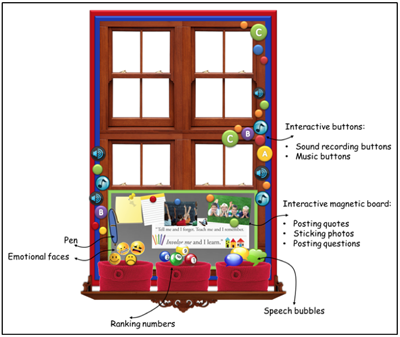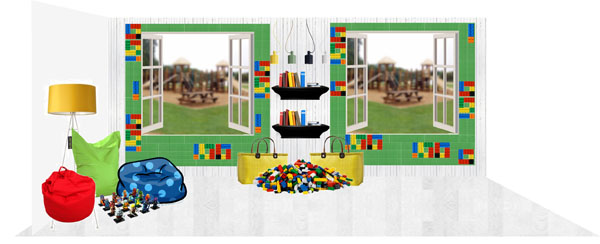Authors: Fatema Qaed
Posted: Thu, April 13, 2017 - 11:37:54
The timing of my fieldwork about learning spaces in Bahrain was during the Arab Spring of 2011. This initially created significant cultural and political difficulties, not just for me, but for many others attempting to collect data about any topic in many Arabic-speaking countries. At the same time, this created a great opportunity. People’s voices were raised in social media, as they were no longer able to present issues through other types of media such as newspapers and TV. As a designer, this was interesting, since it showed the power of users when they decide to create change. I started to search through hashtags related to my research (such as #classroom) and discovered a different way of looking at learning spaces.
Teachers using social media constantly share their problems about the design of classrooms, such as issues of overcrowding. Others kindly reciprocate by sharing how they have overcome these issues through the redesign of space. These everyday solutions are not discussed in academic literature, yet responding to problems, creating solutions, and sharing these on social media feels more authentic and reliable. Teachers are taking action on their own terms without someone monitoring their behavior, as can often happen in more traditional data-collection fieldwork. So social media offered insights into rich virtual communication between people (e.g., with the same hashtag interests) from many cultural backgrounds. I would argue that the diversity of these shared resources and the problem-solution dialogue between users can greatly enrich the way designers understand who it is they are designing with and for.
During my research, I tried to understand the value of learning-space design for its users and why classrooms have stayed the same for a long time. I then wanted to use this to introduce different design concepts for classrooms of the future. The three overlapping phases—contextual review, users’ perceptions of learning spaces, and participatory design—were enriched with particular knowledge from multiple practices of redesign shared on social media resources.
The contextual review phase started by understanding space from my own research perspective, by reviewing the literature about learning theories, learning-space design elements, and the importance of learning spaces for both teachers and students. Online social media resources at this phase played an important role in adding further examples of published theories, but also rich examples of practice. Because many learning theories were implicit in these examples, user perceptions of learning spaces were not always connected to academic literature. Online examples therefore offered a rich clarification of the theoretical knowledge about learning-space design; for example, Figure 1 shows Palatre and Leclère’s color use for nursery school learning spaces. The absence of practical examples in more theoretical accounts encouraged me to look online for further examples that went beyond design as a mediator between theory and practice.

Figure 1. École Maternelle Pajol.
In the second phase of my research, extending my understanding of users’ perceptions, blogs were used to accompany initial fieldwork in Bahrain. I looked at what teachers were doing, saying, and making, in particular the way teachers and students were adapting and redesigning space. This helped to provide insights and raised awareness of users’ voices in learning-space design. The specific research value of social media for both phases was often platform specific.
Facebook: This huge reachable community allowed me to directly communicate with a diverse group of classroom users, across, for example, age range, gender, occupation, countries, and cultures. On Facebook I posted questions publicly on my timeline home page; the two questions were reflections and memories about people’s own classrooms and what a classroom of their dreams would look like.
Twitter: Hashtags in messages (# prefix) enabled search and invited responses on particular topics. This encouraged me to search for tags (e.g., #classroom, #learning_space) to see what users had shared. These searches linked through to wider social networks via hashtags on Pinterest and blogs.
Blogs: As reported in The Guardian newspaper in the U.K., “If you want the truth about school life, read the teachers’ blogs.”
Blogs enabled me to share with teachers their daily activities, as blog data supported close interaction between teachers and myself. Data collected therefore went beyond providing me with problem and solution examples and revealed valuable methods to communicate and interact with teachers.
Flickr: This is a rich image platform and teachers share images of their classroom displays all the time. These images revealed teachers’ competence within everyday design and how to use different design elements to support their teaching methods.
Pinterest can be understood as a visual montage of shared photos from multiple users to become a “catalogue of ideas.” Pinterest search tool enabled a quick visual scan for relevant topics with attached links to websites or blogs of relevant topics. Here, I found a huge, varied, and active teacher network sharing rich teaching and learning experiences, such as classroom activities, classroom makeover examples, teaching tools, and teaching strategies. Pinterest was an especially rich visual data source on how teachers adapt their learning spaces and how they respond to space and objects to support their teaching methods. Additionally, this rich data went some way toward explaining how relationships are built between users and design elements within classrooms.
In the third phase, participatory design, I designed a tool called Classroom Design Recipe, inspired by a Convivial Tool approach. This was developed as a type of teaching assistant to build on both theoretical knowledge and findings on users’ understanding of spatial practice. The box contained different sets of cards (Figure 2) designed to empower teachers’ use of and redesign of learning spaces and facilitate different teaching and learning methods using spatial design elements (wall, flooring, and ceiling).

Figure 2. Classroom Design Recipe cards.
Social media can enrich each phase of design research. If considered early it can be informative to help researchers potentially reflect on academic literature to see how something is put into practice from users’ varied perspectives. It can also help researchers contextually understand problems and how people publicly share that through social media to communicate connections and interests. In my own study, it helped build a better understanding of users, giving examples for diverse solutions where users shared regardless of cultural and geographical boundaries, suggesting potential needs and previously unarticulated ideas. One example of this was how teachers shared images of classroom space, inadvertently showing how they used windows as display boards. This inspired me to suggest different design opportunities, combining social media visuals with students’ ways of learning and teachers’ ways of teaching (Figures 3 and 4).

Figure 3. Interactive window design.

Figure 4. Lego window design.
Social media includes an ever-increasing variety of free platforms that can empower designers to understand users’ diverse needs, communicate with them closely, and potentially design better solutions. Much of the current literature highlights the value of “big data” constructed by users in social media. However, from a design perspective the real value, in my own experience, was in creatively capitalizing on these multiple varieties of data to gain different perspectives from interconnected communication resources.
Posted in: on Thu, April 13, 2017 - 11:37:54
Fatema Qaed
View All Fatema Qaed's Posts







Post Comment
@BethanyDamian (2025 08 17)
I’ve seen how design research and social media complement each other in shaping user experiences. In bpo services outsourcing my work, analyzing audience behavior on social platforms provides real insights that guide design choices. I believe this approach not only improves engagement but also ensures designs remain relevant, impactful, and user-focused.